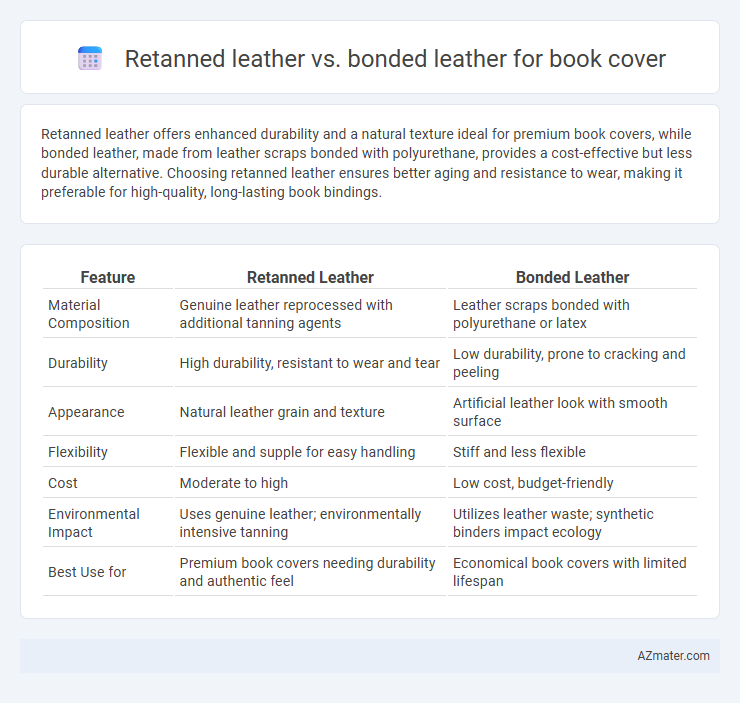Retanned leather offers enhanced durability and a natural texture ideal for premium book covers, while bonded leather, made from leather scraps bonded with polyurethane, provides a cost-effective but less durable alternative. Choosing retanned leather ensures better aging and resistance to wear, making it preferable for high-quality, long-lasting book bindings.
Table of Comparison
| Feature | Retanned Leather | Bonded Leather |
|---|---|---|
| Material Composition | Genuine leather reprocessed with additional tanning agents | Leather scraps bonded with polyurethane or latex |
| Durability | High durability, resistant to wear and tear | Low durability, prone to cracking and peeling |
| Appearance | Natural leather grain and texture | Artificial leather look with smooth surface |
| Flexibility | Flexible and supple for easy handling | Stiff and less flexible |
| Cost | Moderate to high | Low cost, budget-friendly |
| Environmental Impact | Uses genuine leather; environmentally intensive tanning | Utilizes leather waste; synthetic binders impact ecology |
| Best Use for | Premium book covers needing durability and authentic feel | Economical book covers with limited lifespan |
Introduction to Retanned and Bonded Leather
Retanned leather for book covers undergoes a secondary tanning process that enhances durability, flexibility, and water resistance, making it ideal for high-quality, long-lasting bindings. Bonded leather is made by combining leather scraps with polyurethane or latex on a fiber backing, resulting in a cost-effective material with the appearance of genuine leather but reduced strength and longevity. Retanned leather exhibits superior texture and aging properties, whereas bonded leather offers an affordable option with limited durability for decorative purposes.
What Is Retanned Leather?
Retanned leather refers to leather that undergoes a secondary tanning process after the initial tanning, enhancing its durability, flexibility, and resistance to wear, making it ideal for book covers requiring long-lasting protection. This type of leather maintains its natural grain and texture, offering a premium, high-quality finish that ages gracefully over time. In contrast, bonded leather combines shredded leather fibers and polyurethane, resulting in a less durable and lower-cost material often used for budget-friendly book covers.
Understanding Bonded Leather
Bonded leather, made from shredded leather fibers mixed with polyurethane and other materials, offers a cost-effective and uniform alternative to genuine leather for book covers. This composite material provides moderate durability and a smooth texture but tends to wear and peel over time, especially with frequent handling. Understanding the production process and material limitations of bonded leather helps in selecting the right cover option based on durability and aesthetic preferences.
Durability: Retanned vs Bonded Leather
Retanned leather exhibits superior durability for book covers due to its full grain structure and additional tanning process, which enhances strength and resistance to wear. Bonded leather, made from shredded leather fibers bonded with polyurethane or latex, tends to degrade faster, showing peeling and cracking over time. Therefore, retanned leather provides a longer-lasting, more resilient option for high-quality book cover applications.
Aesthetic Appeal and Texture
Retanned leather for book covers offers a rich, natural texture with a deep, luxurious patina that enhances aesthetic appeal over time, showcasing unique grain patterns and a supple feel. Bonded leather, composed of leather scraps bonded with polyurethane, tends to have a uniform, smooth surface that mimics genuine leather but lacks the authentic texture and aging characteristics. The tactile experience of retanned leather is notably more refined and durable, making it a preferred choice for premium bookbinding where visual and textural sophistication is paramount.
Cost Comparison: Retanned vs Bonded Leather
Retanned leather for book covers generally commands a higher price due to its durable quality and longer lifespan compared to bonded leather, which is made from leather scraps bonded with polyurethane or latex. Bonded leather offers a budget-friendly alternative but tends to wear out faster, making it cost-effective only for short-term use. The initial investment in retanned leather often translates to better value over time, especially for premium or frequently handled books.
Environmental Impact and Sustainability
Retanned leather for book covers involves a process that reuses animal hides with environmentally friendlier tanning agents, reducing chemical waste and promoting durability. Bonded leather combines leather fibers with synthetic materials and adhesives, leading to shorter lifespan and higher environmental strain due to non-biodegradable components. Choosing retanned leather supports sustainability by extending the life cycle of natural hides and minimizing harmful ecological footprints compared to bonded leather alternatives.
Feel and Flexibility for Book Covers
Retanned leather offers a supple feel and enhanced flexibility ideal for book covers, providing durability and a natural texture that ages gracefully. Bonded leather, made from leather scraps bonded with polyurethane or latex, tends to feel stiffer and less flexible, often resulting in a synthetic finish that can crack over time. The superior pliability and authentic tactile experience of retanned leather make it a preferred choice for high-quality book covers.
Maintenance and Longevity
Retanned leather offers superior durability and ages gracefully, requiring minimal maintenance such as occasional conditioning to prevent drying and cracking. Bonded leather consists of leather scraps bonded with adhesives, making it less resistant to wear and prone to peeling or flaking over time, which demands more frequent care and replacement. For long-lasting book covers, retanned leather is preferred due to its enhanced resilience and longevity.
Choosing the Right Leather for Your Book Cover
Retanned leather offers durability, a rich texture, and natural breathability, making it ideal for high-quality book covers that age beautifully over time. Bonded leather, composed of leather scraps mixed with adhesives, provides an affordable alternative but often lacks longevity and may peel or crack with frequent use. For a premium, long-lasting book cover, retanned leather is the preferred choice due to its strength and authentic aesthetic.

Infographic: Retanned leather vs Bonded leather for Book cover
 azmater.com
azmater.com